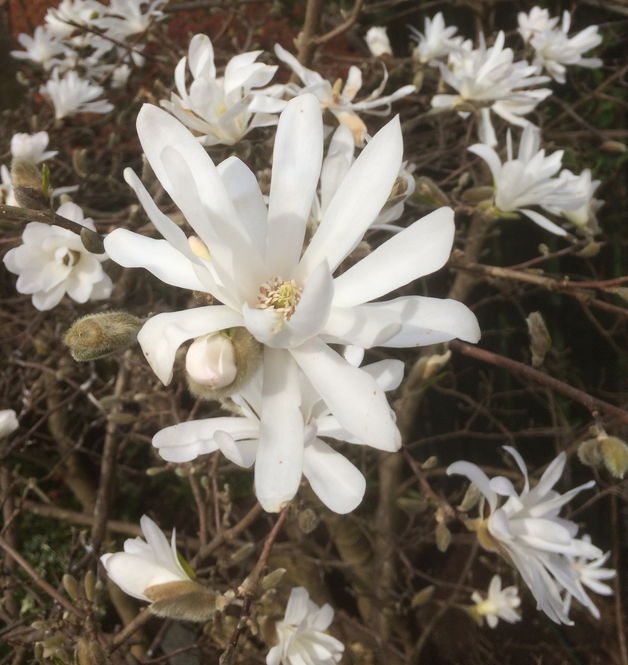The musings of a plant fanatic
by Maurice Wilkins
If I’ve learnt anything from my years as a professional gardener in the west of Scotland it’s this; the world is full of amazing plants which enjoy - or at least tolerate - our comparatively mild climate, and yet very few keen gardeners grow them!
Scroll down to see ‘Plant of the month’!
So why is this? Almost certainly because they don’t know about them! Very few garden centres, in particular those owned by large companies, grow much outside a limited range of plants and it’s not unusual to find the same plants for sale in Oban as it is in Canterbury or Birmingham. OK, many special plants are what are sometimes known as ‘plantsman’s plants’, which suggests that they are unlikely to sport huge brightly coloured double flowers and bloom from February to November. It’s possible that their charm may lie in the fact that they are different, they come from strange places, or they are simply rare - or sometimes a combination of everything!
Fortunately for the gardening fanatics among us there are many smaller nurseries scattered around the UK which are run by equally fanatical growers, and all you have to do is to find them! In my youth it would have been difficult to track down the suppliers of the rare and unusual, but in these Internetical days - if there is such a word! - there’s no excuse. Well I suppose there is - you can’t look for plants if you’ve never heard of them.
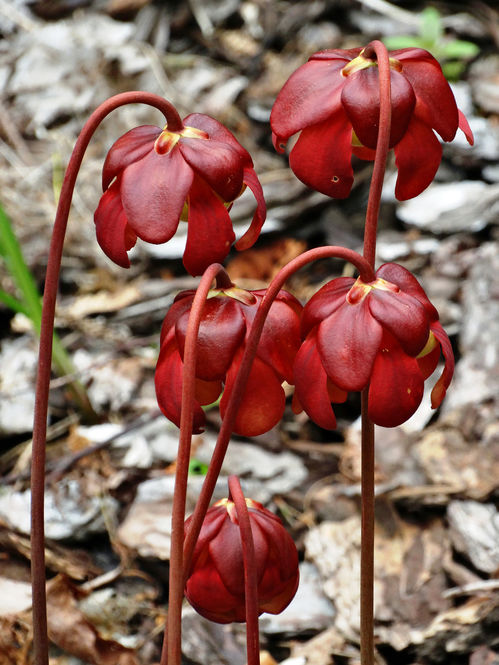
In this blog I’m going to have a go at describing a number of plants which I’ve grown in my time in Scotland’s west, mostly outsiders but occasionally insiders, for which I’ve had to go a little further than the local garden centre. They may not all be beautiful - in fact some might be weird! Watch this space for ‘Plant of the Month’!
August
Plant of the Month - Rostrinucula dependens
One of the fun things about ferreting about in the websites of unknown nurseries - unknown to me, I mean - is that once in a while I come across something really unusual. Even better, of course, is to find something that I’ve never heard of before! It’s not unusual to find an unknown species from a well-known genus, but to find a genus which is a total surprise doesn’t happen very often.
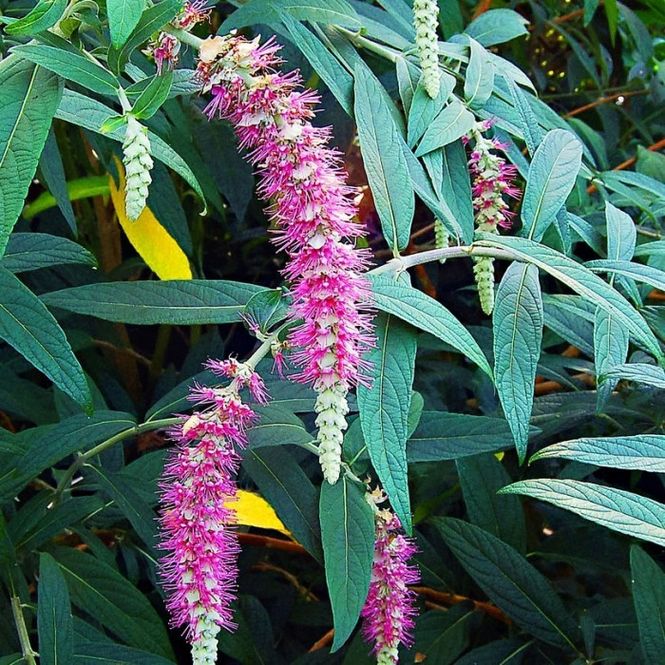
Last spring while browsing a website I noticed the name Rostrinucula dependens, common name ‘Weeping Buddleja’, though it’s unrelated to that genus. It was totally new to me and I had great difficulty in trying to pronounce it - it doesn’t trip off the tongue! It has a sister species, R. sinensis, both being natives of southern and central China, growing on hills and cliffs in Guangxi, Guizhou, Hubei and Hunan. According to Hillier’s Manual it was introduced only in 1985 which was quite a surprise! Of course I had to order a plant, but when it arrived it proved to be a rather scruffy specimen so I complained and was given 50% off!
I pruned it quite hard and within a short time it had produced a number of new shoots. Naturally I cut them all off and rooted them - why wouldn’t I! The original plant is growing on the bank above my house where it’s come through the last winter - it’s supposed to be reasonably hardy in most parts of Britain. This species apparently grows to 5 or 6ft and flowers in late summer and autumn. I don’t think mine will flower this year, but I’m very hopeful for 2024! It’s available from several UK nurseries, but I wouldn’t be surprised if it begins to appear in garden centres before too long. You could have the first one in your street!
July
Plant of the Month - Myosotidium hortensia
If you happened to find yourself wandering along the shoreline on one of the Chatham Islands, an isolated Pacific Ocean island group some 500 miles east of South Island, New Zealand, you might notice some spectacular evergreen perennial plants growing in the sand among the rocks. You would be astounded by the huge heads of bright blue flowers which you might have thought looked like giant forget-me-nots.
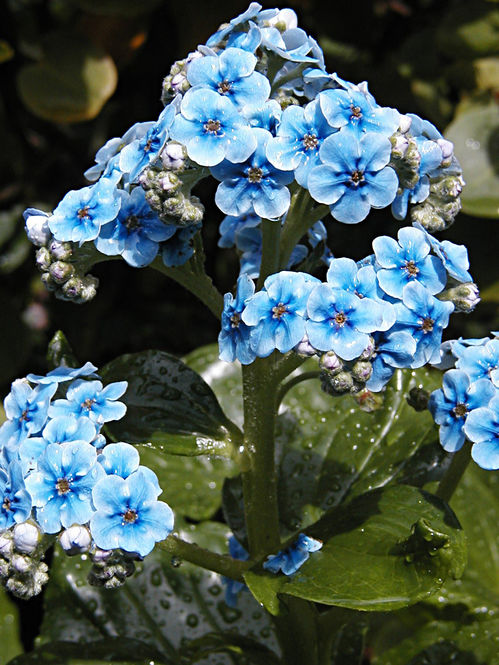
You would be right - Myosotidium hortensia, the Chatham Island forget-me-not, is endemic to those islands, but you might be surprised to hear that it can be grown outside in the UK, especially in milder areas. I first saw this plant growing in the garden of Tyninghame House, near Dunbar, many, many years ago. I’m not entirely sure when I first grew it, but records show that in 1996, four years after I’d began work at Arduaine, I obtained some seed, in a roundabout way, that came from a plant in the garden at Brodick, on the Isle of Arran.
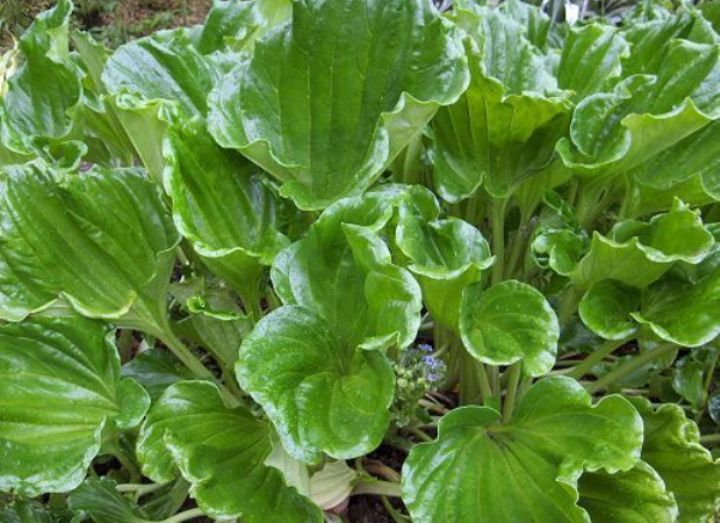
The resulting specimens were eventually planted out in a bed down beside the ponds, probably only 50 or 60 yards from the sea, where they grew to around two feet and flowered for many years. The foliage is dramatic - large, evergreen, ribbed and glossy. In flower they are even more dramatic - one of my favourite perennials of all time! A little later on I discovered that there was a white form and grew that for a while, though it couldn’t match the splendour of the original blue.
They are said to enjoy a diet of rotting fish, but if that’s unavailable then a well-drained but moist soil will do, maybe with a mulch over winter. In colder places they will do well in the conservatory, though the smell of rotting fish might be rather off-putting! Whichever way you can do it, it’s very well worth a try - if you can find one, that is!
June
Plant of the Month - Grevillea rosmarinifolia
We usually think of Australia as being a hot place whose native plants will not be hardy in the UK, but many plants from the south-east do well on Scotland’s west coast. I’ve grown several over the years, but one of my favourites is Grevillea rosmarinifolia, a shrub in the Protea family. It’s native to SE Australia, but apparently naturalised all over the continent.
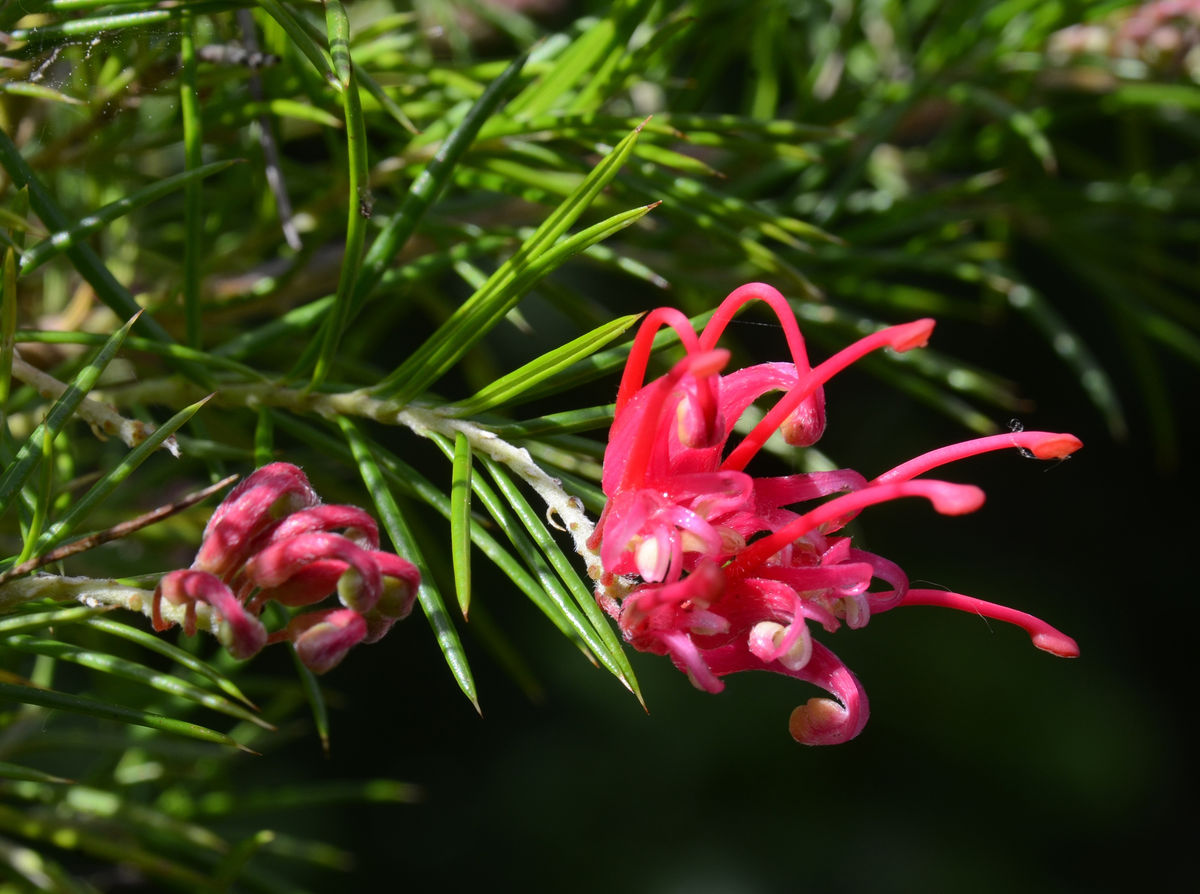
The foliage is short and spiky and quite similar to the well-known culinary shrub rosemary, hence the name. The flowers, however, are very distinct and exotic and described as red, though I would call them a very deep pink - I’ll leave you to decide from the photograph.
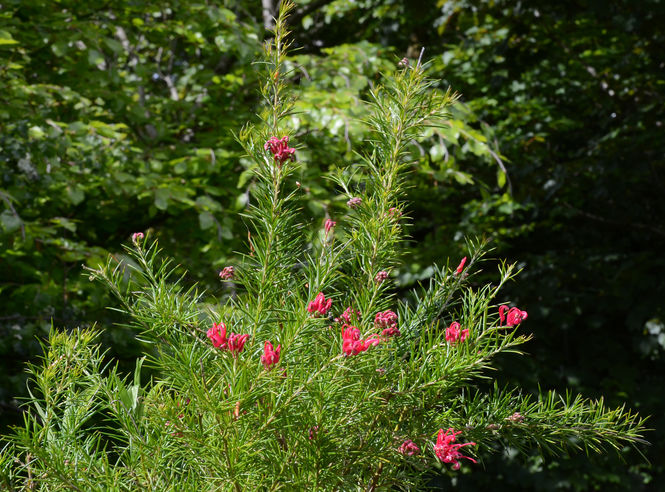
My plant is in a pot on the deck for the moment as I don’t have any wall space - my bungalow is surrounded by decking, gravel and paving just now, though I might need to make some changes. I’ve always assumed that it’s a plant for a warm wall, though I recently saw a lovely specimen in Dr Neil’s Garden at Duddingston in Edinburgh - quite a bit colder that Scotland’s West Coast, I would have thought!
It’s a medium-sized shrub, possibly up to 4- 5ft or so wide and high, and prefers a reasonably dry site and one with well-drained and rather hungry soil. Proteaceae generally are intolerant of phosphates so it’s best not to feed or mulch as you might with other shrubs.
Hillier’s Manual of Trees and Shrubs suggests that the Grevillea rosmarinifolia in cultivation is a hybrid with Grevillea lanigera, but if that’s the case I don’t let it worry me!
May
Plant of the Month - Euphorbia mellifera
The Euphorbia family is one of the largest in the plant world, with more than 2,000 members. Rather confusingly these range from small annuals, to perennials, shrubs, cacti and succulents and even trees! I have a funny feeling that somewhere out there is a taxonomist who is eyeing them up, thinking that the family should be divided into numerous differently named species! But I hope that I’m wrong.
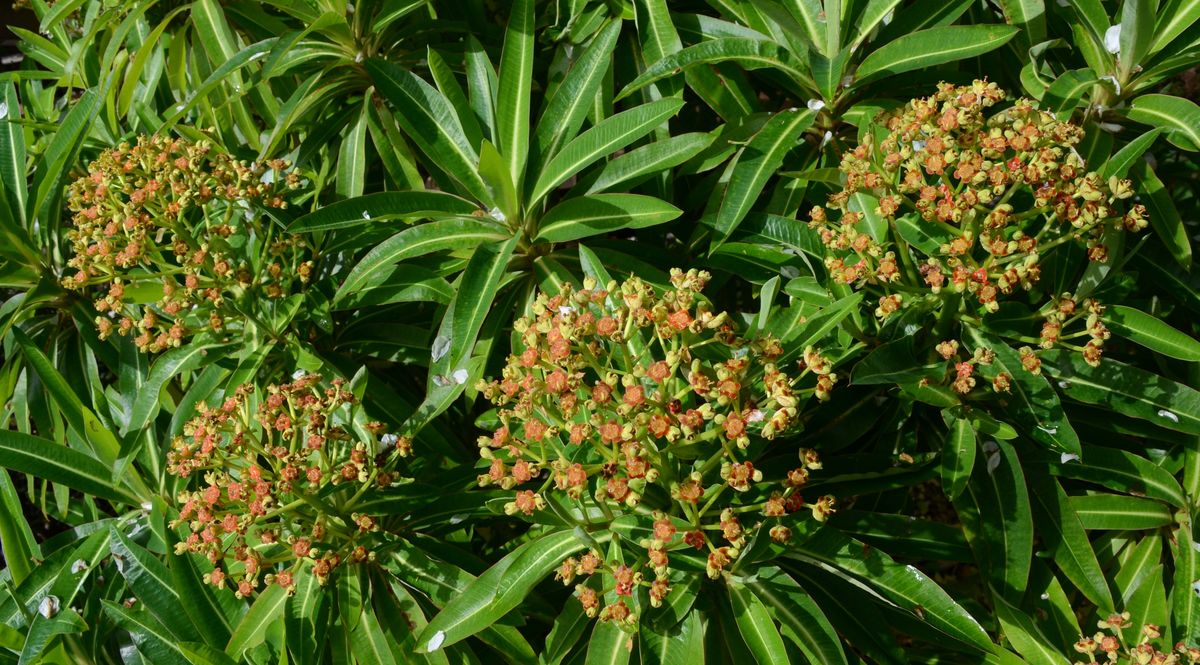
Euphorbia mellifera is a true shrub, hailing from Madeira and the Canary Islands, and seems quite hardy here on the west coast, though it might need protection further inland. Its common name is the Honey Spurge, spurge being the everyday name for euphorbias in general. The flowers, which are produced in early spring, are orangey-brown, have a wonderful honey fragrance and are followed by clusters of small, pea-like seeds. This shrub, which is of medium to maybe large size, is rounded in shape and evergreen, and the foliage is attractive in its own right, being long, narrow and acid-green, with a pale stripe down the centre.
Euphorbia mellifera was already growing at Arduaine when I arrived there in 1992 and continued to flourish, producing quite a number of self-sown seedlings. One of these seedlings is doing very well in my garden in Oban and has flowered well this year. Probably the only downside is the fact that in common with all euphorbias this shrub has a white, irritant sap which should be kept away from skin and eyes. It’s supposedly harmful if eaten, though I have to say that I’ve never tried it!
All round a beautiful shrub for a sunny spot and very easy to grow. Give it a try!
April
Plant of the Month - Bilbergia nutans
As I mentioned last month, plants are loosely classified into informal groups, one being the bromeliad. Members of this group are rarely seen growing outdoors in our climate, though Fascicularia and Puya are both possibilities. The best known in the group is probably the pineapple, Ananas comosus, but there are a number of other genera which can be grown as houseplants - Vriesea and Aechmea are two that are often seen in garden centres.
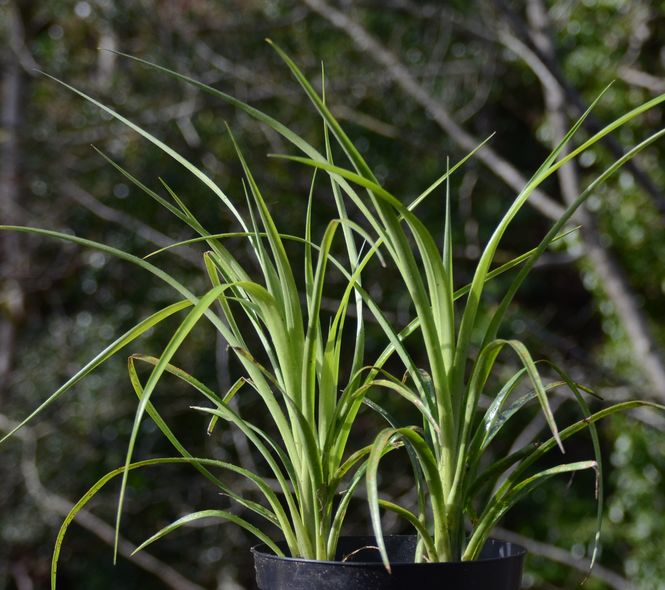
A bromeliad that I’ve grown under glass over the years is Bilbergia nutans, sometimes known as Queen’s tears; I don’t know which queen did the crying! It had never occurred to me that it might be reasonably hardy as it’s native to Central and Southern America, where like most bromeliads it’s generally seen perching in the forks of trees. With a limited root run the plants collect rainwater in their rosettes.
Some years ago I thought I’d experiment with a specimen that I had in the glasshouse at Arduaine. It was quite a sizeable one, so one spring I took it out of its pot and squeezed the rootball into the fork of an old willow tree, where I tied it in place to prevent it being blown out before the roots got a grip. It was still alive and looking fine when I retired a few years later, so I think it’s worth a try here in Oban.
I have several plants which have been sitting in pots under the eaves of the house for a few years, so I’ll look for some sites for them. As with many plants of borderline hardiness it’s best to get them out just as soon as the threat of heavy frost is past, to give them a long growing season before the next winter.
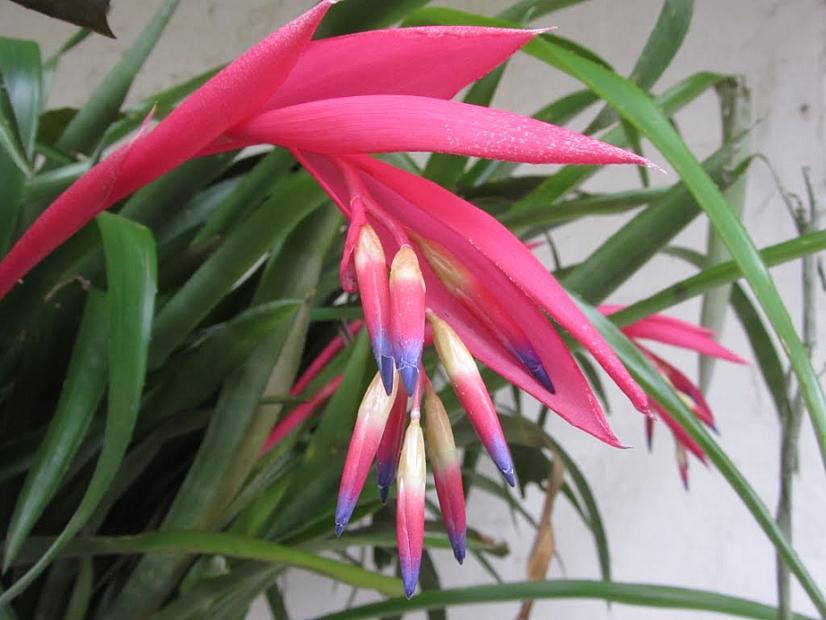
March
Plant of the Month - Wollemia nobilis
Well, so far I’ve talked about an indoor plant, a shrub, a tuberous perennial and a fern, so this time we’ll have a conifer. Now there are conifers and conifers, huge species and dwarf varieties, deciduous and evergreen, long-known and recently discovered.
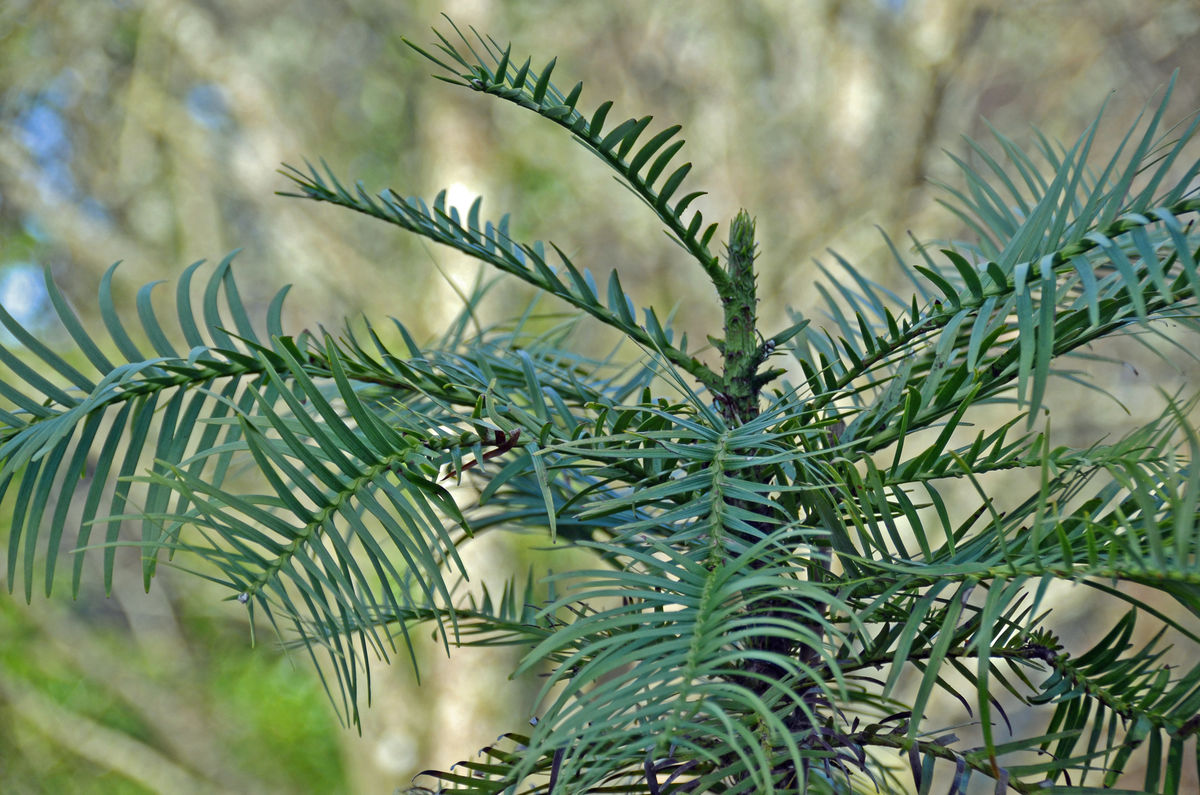
Wollemia nobilis, known as the Wollemi Pine, comes under the latter category; it shares a family with the Monkey Puzzle tree. I find it really hard to imagine, but it was first discovered only in 1994, no, not 1894, 1994, and just 125 miles NW of Sydney, Australia! To quote the website - “Wollemi Pines are restricted to approximately 40 adult and 200 juvenile trees growing in the Wollemi National Park of New South Wales.”
They grow in deep gorges and were discovered by David Noble while abseiling into one of the gorges, a popular sport in the area. Apparently he didn’t recognise them and took a piece back to a botanist friend who must have had a fit - they were thought to have been extinct for two million years!
They’ve been on the market since 2004 and I bought one for Arduaine. They are certainly the ‘must have’ plant these days and are generally hardy in the UK. I even have one in my Oban garden, given to me by a friend who had rooted it from a double leader on his tree. Unfortunately a roe deer chewed the top off and uprooted it, but it’s back in the ground again and growing happily. They do eventually grow to a large size, so don’t plant it in front of the living room window! Since writing this I’ve decided to donate my plant to the garden at Dunollie, in Oban, where they have a little more room to grow a potentially large conifer than I do!
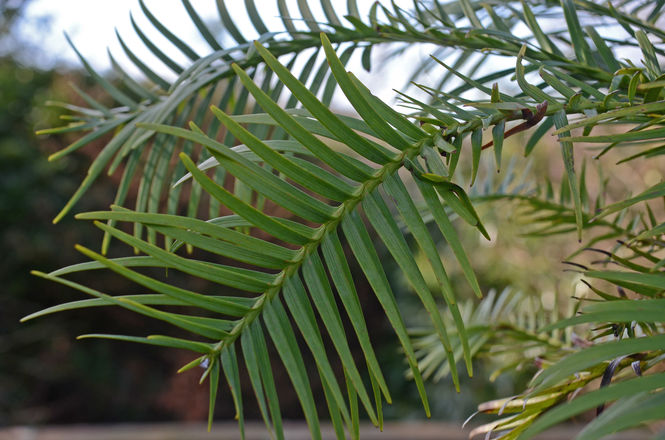
February
Plant of the Month - Lophosoria quadripinnata
Someone once told me ‘All ferns are bracken’! I had the opportunity to plant a large collection of ferns at Arduaine, ranging from tiny species which grow in cracks in the rocks to tree ferns, which can grow extremely tall, and of an infinite number of frond shapes, colours and textures, so I knew this was not the case! This month my blog is about one of the tallest of the ‘non-tree’ ferns, Lophosoria quadripinnata.
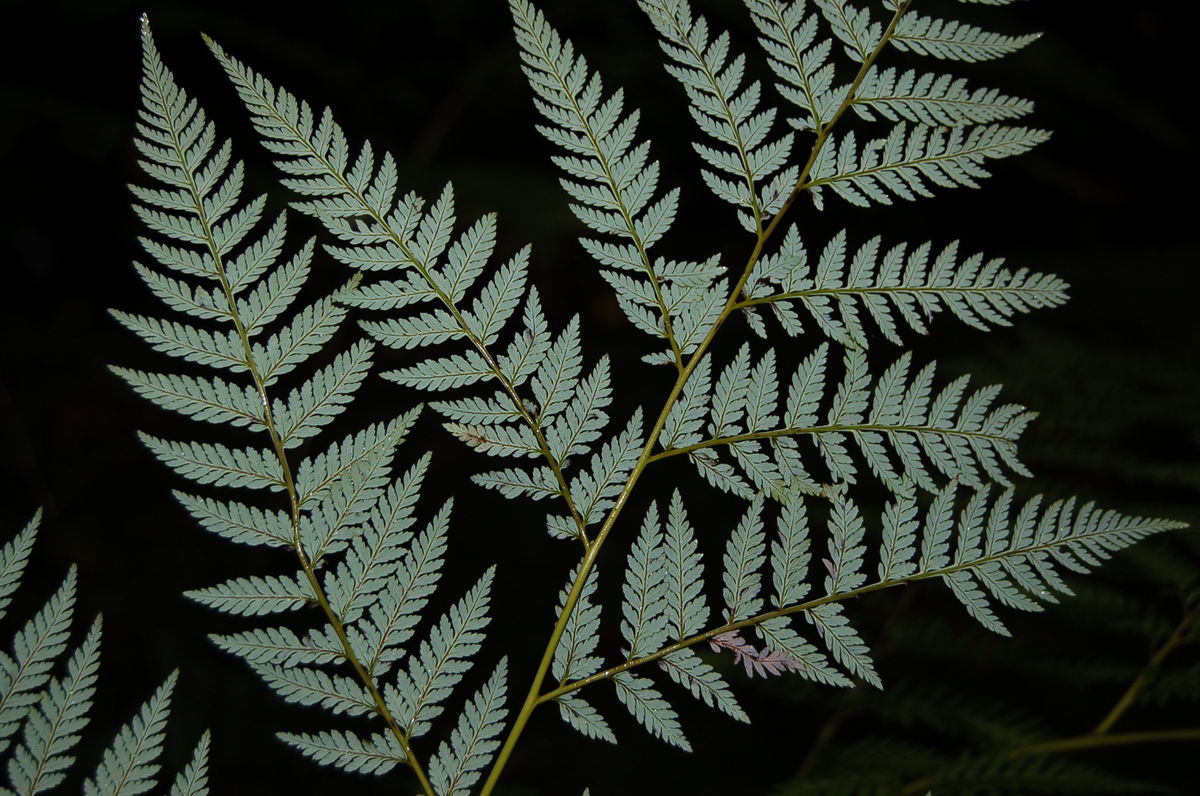
Many years ago the Royal Botanic Gardens in Edinburgh gave me three tiny Lophosoria in 3” pots, which I grew on for some time before planting out. It’s a magnificent species which eventually grew very large at Arduaine, planted in a shaded and sheltered spot. The fronds were something in the region of 10-12ft tall and one day, after taking several photographs which really didn’t show its size, I walked out to the path and asked a couple of ladies if they would be prepared to follow me into the woods for a photograph! I explained that they were wanted to show scale, and so they agreed! I’ve shown the picture here, not great quality, but it came from a scanned slide. This fern is native to Central and South America and is hardier than generally supposed. On a visit to Chile in 2005 I saw this fern everywhere, in woodlands, beside waterfalls and even growing in tubs outside a petrol station!
Apart from its size the most striking feature of this fern is the underside of the frond which is a beautiful pale metallic blue, glaucous I suppose you might call it. The unfurling fronds too are quite amazing and as the plants grows larger these become quite dramatic. Give it a go in a sheltered spot and be the envy of the neighbours!
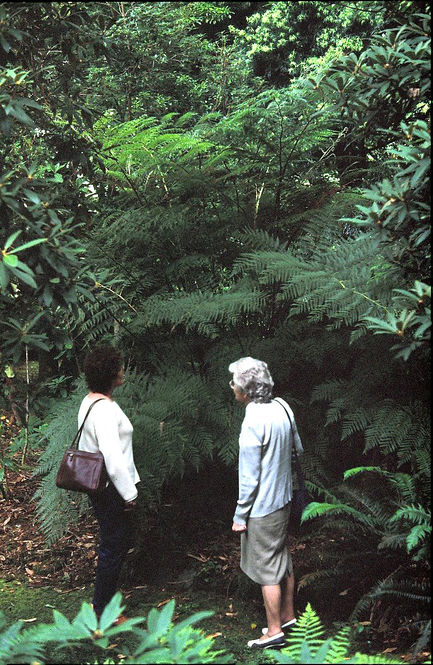
January
Plant of the Month - Leycesteria crocothyrsos
Many of us are familiar with Leycesteria formosa, the commonly called Pheasant Berry or Himalayan honeysuckle, which though an attractive shrub seeds around everywhere and is becoming a pest in many areas including Scotland - Oban has loads of it. Never fear - there’s an even more attractive alternative!
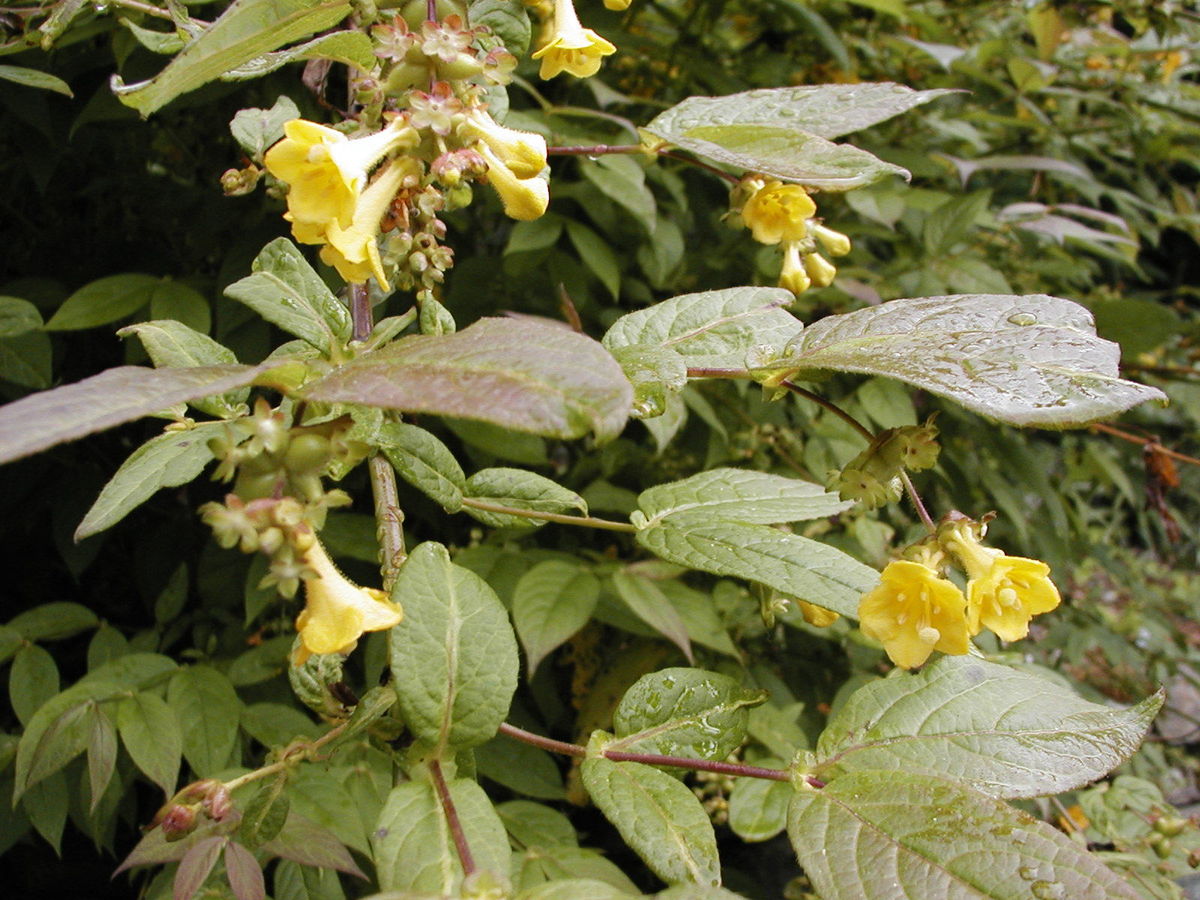
The Pheasant Berry’s sister species, Leycesteria crocothyrsos, is less hardy and more difficult to pronounce, which are probably both reasons for its scarcity, but I grew it for a number of years at Arduaine without frost damage so it’s well worth trying. I remember seeing this species for the first time at Logan Botanic Gardens, where it grew on the terrace at the top of the garden - I just had to have it! It’s a deciduous shrub with fairly large, bronzy, slender pointed leaves on hollow stems. The flowers are similar in shape to those of its sister, but of a most beautiful golden yellow, borne in pendulous terminal racemes and followed by small green berries. OK, the berries may not be as attractive as the purple-red ones of L. formosa, but you can’t have everything!
It deserves a sheltered spot and grows to around 5-6ft, or a couple of metres to younger enthusiasts! It’s a native of northern India (Assam) and round about, including northern Myanmar, which of course was Burma in the old days! It was originally introduced in 1928 by Frank Kingdon-Ward, and again more recently by Roy Lancaster. Plants grown from his seed collection are reputed to be hardier. Go on - give it a go!
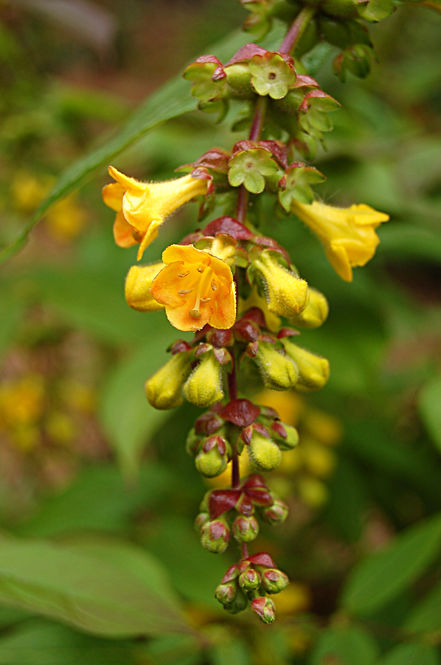
December
Plant of the Month - Bomarea edulis (Salsilla)
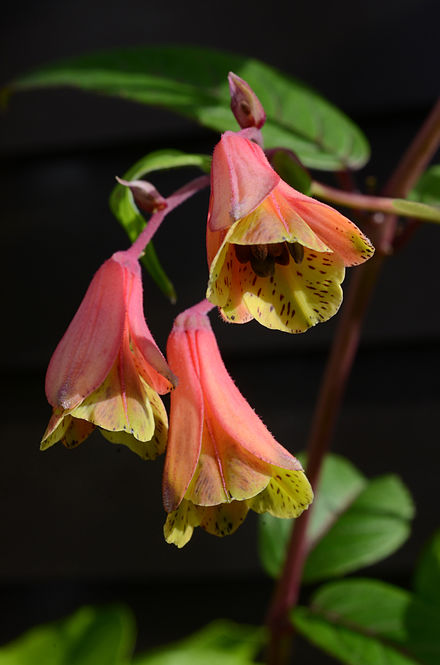
I’m not sure what attracted me to the generally twining genus Bomarea, related to the better-known Alstromeria, but I’ve grown several of the species over the years. The only one that I grow now is Bomarea edulis, which as its name suggests, is edible, or rather the tubers are. They’re supposed to taste like Jerusalem artichokes, but as I’ve never knowingly eaten one of those I can’t really comment!
This plant has a wide distribution through Central and South America, probably widened through its cultivation, but it was first discovered in 1768 in Rio de Janeiro by botanists on Captain Cook’s ship, the Endeavour.
It seems quite hardy in my Oban garden, which in spite of what the weather websites say does get a fair amount of frost, being some 220ft above sea level. My plant is still in a large clay pot though maybe next spring I will plant it out to scramble up a shrub or on a trellis on the house wall.
A herbaceous climber, it grows annually to 6-8ft, supported on tall canes. The leaves are simple and lanceolate and the flowers are narrowly tubular, salmon pink outside and yellow and green with purple dots inside. The bursting seeds pods are spectacular too! Mine was still flowering outside in the middle of November and is only just beginning to die back. In colder places the pot could be overwintered in a greenhouse or frame, but mine has stood outside here for the last six winters. One day I might try eating one of the tubers!
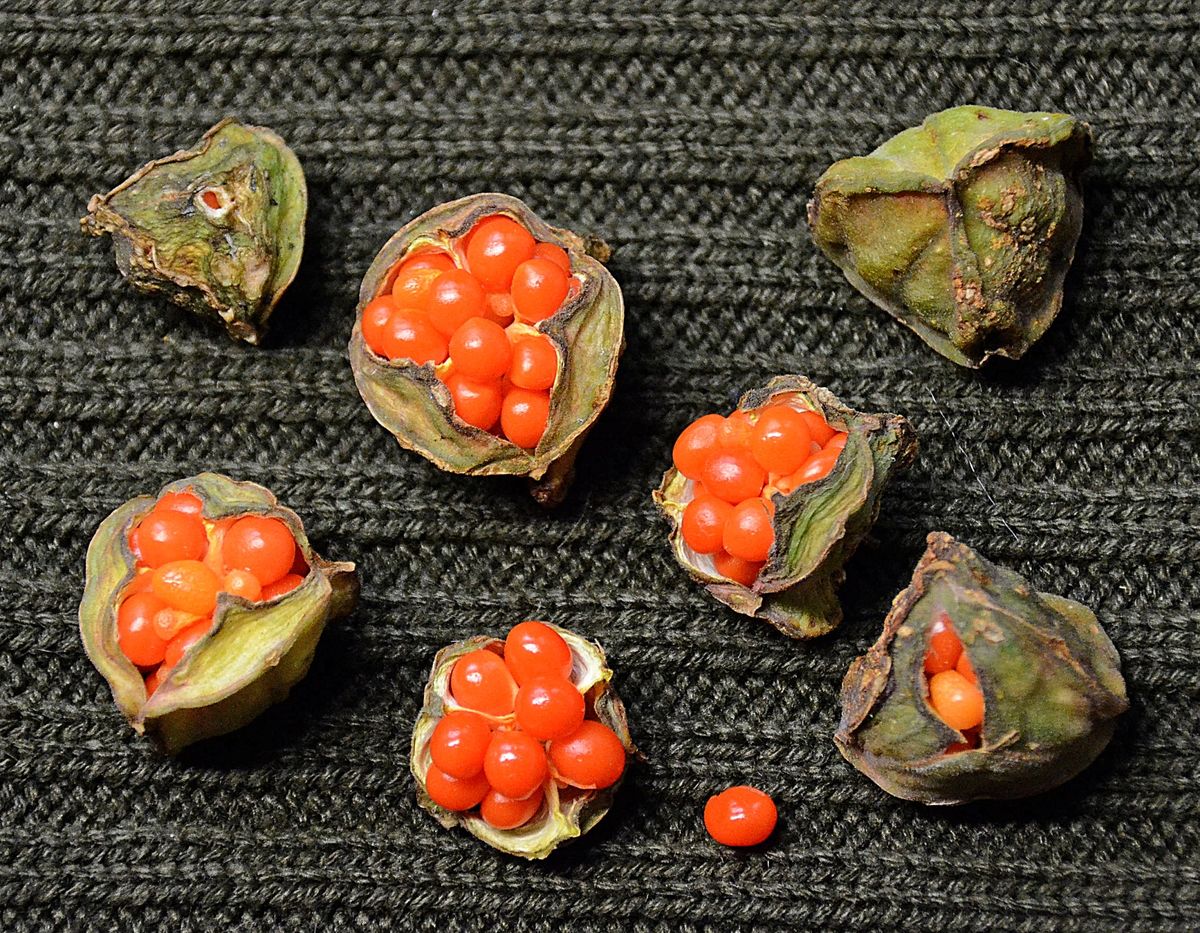
November
Plant of the Month - Begonia hatacoa PGG 209
I’m going to begin this blog with a plant which is very special to me and which is not commonly grown. It’s a begonia, a species by the name of Begonia hatacoa PGG 209, which is a native to several countries in the Far East.
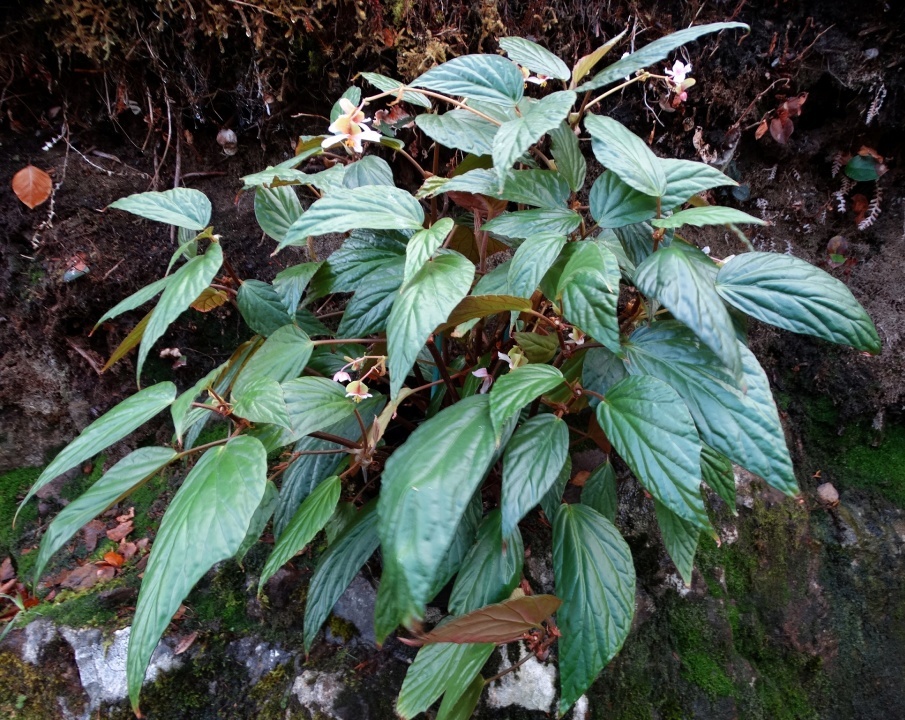
The suffix PGG 209 indicates that it was collected in the wild, the PGG standing for Professional Gardeners’ Guild, a group of colleagues I travelled with. It was in fact grown from seed which I collected in Nepal on 3rd November 1990, and I’ve propagated it from cuttings ever since so that all resultant plants can legally bear the suffix PGG 209.
It’s not very hardy, so I keep it as a houseplant where it enjoys a light position, out of hot sun; it can be grown outside during the summer. I didn’t know which species it was when I saw it, so my collecting notes say “Begonia species, growing in deep shade on a steep bank, between Sekathum and Chirwa, altitude 1500m. Foliage 12cms x 7cms, pale green, glossy.”
I identified it later on, once it had flowered, and because of its wild origin, Glasgow Botanic Garden was prepared to accept it into their National Begonia Collection. Not the most spectacular of begonias maybe, but it means a lot to me and will always remind me of tramping through the deep, dark forests of Nepal!
About the author

At the age of seventeen Maurice decided on a complete change of career, from a civil servant to a gardener, and has never looked back!
After a few years’ employment with a garden contractor in Surrey he worked in the Woodland Garden in Bushy Park, Hampton Court, in the garden at Holyrood Palace in Edinburgh and then took up his first Head Gardener post at Ross Priory on Loch Lomond.
After sixteen years there he moved westwards to manage Arduaine Garden (and Crarae Garden too for a couple of years) in Argyll, from where he retired after twenty-four years in 2016.
He has spent many years leading garden tours, has been plant hunting in Chile and the Himalayas, and finally settled down to grow unusual plants on a cliff in Oban!


 Find a Garden
Find a Garden

 What's New
What's New

 Our Impact
Our Impact

 Join
Join
